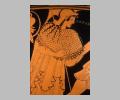The Parthenon
The new temple built for Athena on the acropolis became known as the Parthenon,
meaning “the house of the virgin goddess,” from the
Greek
word for a virginal female1, parthenos. As the patron godddess of Athens,
Athena had long possessed another sanctuary on the acropolis.2 Its focus was an olive tree regarded as the sacred symbol of the goddess, who
was believed to provide for the economic health of the Athenians. Athena's temple in
this earlier sanctuary had largely been destroyed by the Persians in the invasion of
480 B.C. For thirty years, the Athenians purposely left the Acropolis in ruins as a
memorial to the sacrifice of their homeland in that war. When Pericles urged the
rebuilding of the Acropolis' temples, the assembly turned not to reconstruction of the
olive-tree sanctuary, but rather to construction of the Parthenon. The Parthenon
honored Athena not in her capacity as the provider of economic prosperity but as a
warrior serving as the divine champion of Athenian military power. Inside the
Parthenon,
the gold and ivory statue,3 over thirty feet high, portrayed the goddess in battle armor
and holding in her outstretched hand a six-foot statue of the figure of Victory
(Nike in Greek).
The Parthenon's design
Like all Greek temples, the Parthenon itself was meant as a house for its deity,
not as a gathering place for worshippers. In its general design, the Parthenon was
representative of the
standard architecture of Greek
temples:4 a rectangular box
on a raised platform, a plan that the Greeks probably derived from the stone temples
of Egypt. The box, which had only one relatively small door at the front, was fenced
in
columns all around.5 Normally only priests and priestesses could enter the boxlike interior of
the temple; public religious ceremonies took place around the
open-air
altar,6 which was located outside the east end
of the temple. The soaring columns of the Parthenon were carved in the simple style
called Doric, in contrast to the more elaborately decorative Ionic or Corinthian
styles that have often been imitated in modern buildings. The facade of the United
States Supreme Court Building in Washington, D.C., for example, is built in the
Corinthian-style.
The Parthenon's special architecture
The Parthenon was special in its great size and elaborate decoration. Constructed
from 20,000 tons of Attic marble, it stretched nearly 230 feet in length and a
hundred feet wide, with
eight columns7 across the ends instead of the six normally employed in Doric style, and
seventeen instead of thirteen along the sides. These dimensions gave it a massive
look conveying an impression of power. Since perfectly rectilinear architecture
appears curved to the human eye, the Parthenon's architects ingeniously designed
subtle curves and inclines in its architecture to produce an optical illusion of
completely straight lines: the columns were given a slight bulge in their middles;
the corner columns on the corners of the temple's raised platform were installed at
a slight incline and closer together; the platform itself was made slightly convex.
These technical refinements made the Parthenon appear ordered and regular in a way a
building built entirely on straight lines would not. By overcoming the distortions
of nature, the Parthenon's sophisticated architecture made a confident statement
about human ability to construct order out of the entropic disorder of the natural
world.
Sculpture on the Parthenon
The sculptural decoration of the
Parthenon 8 also proclaimed Athenian confidence about their city-state's relationship
with the gods, whom the citizens regarded as their helpers and supporters. The
Parthenon had sculptured panels along its exterior above the columns and
tableaux of sculptures in the triangular spaces
(pediments)9 underneath the roof line at
both ends of the building. These decorations were part of the
Doric 10 architectural style, but the Parthenon also presented a unique sculptural
feature. Carved in relief around the top of the walls inside the porch formed by the
columns along the edges of the building's platform was a continuous band of figures.
This sort of continuous frieze was usually put only on Ionic-style buildings. Adding
an
Ionic11 frieze to a Doric temple was a striking change meant to attract notice to
its subject. The Parthenon's frieze depicted the Athenian religious ritual in which
a procession of citizens paraded to the Acropolis to present to Athena in her
olive-tree sanctuary a
new robe woven by specially selected Athenian
girls12 (the Panathenaic festival). Depicting the procession in motion, like a
filmstrip in stone, the frieze showed
men riding spirited horses13, women walking along carrying sacred implements, and the
gods
gathering together at the head of the parade14 to observe their human worshippers. As usual in the sculptural decoration on
Greek temples, the Parthenon frieze sparkled with brightly colored paint enlivening
the figures and the background. Shiny metal attachments also brightened the picture,
serving, for example, as the horsemen's reins.












